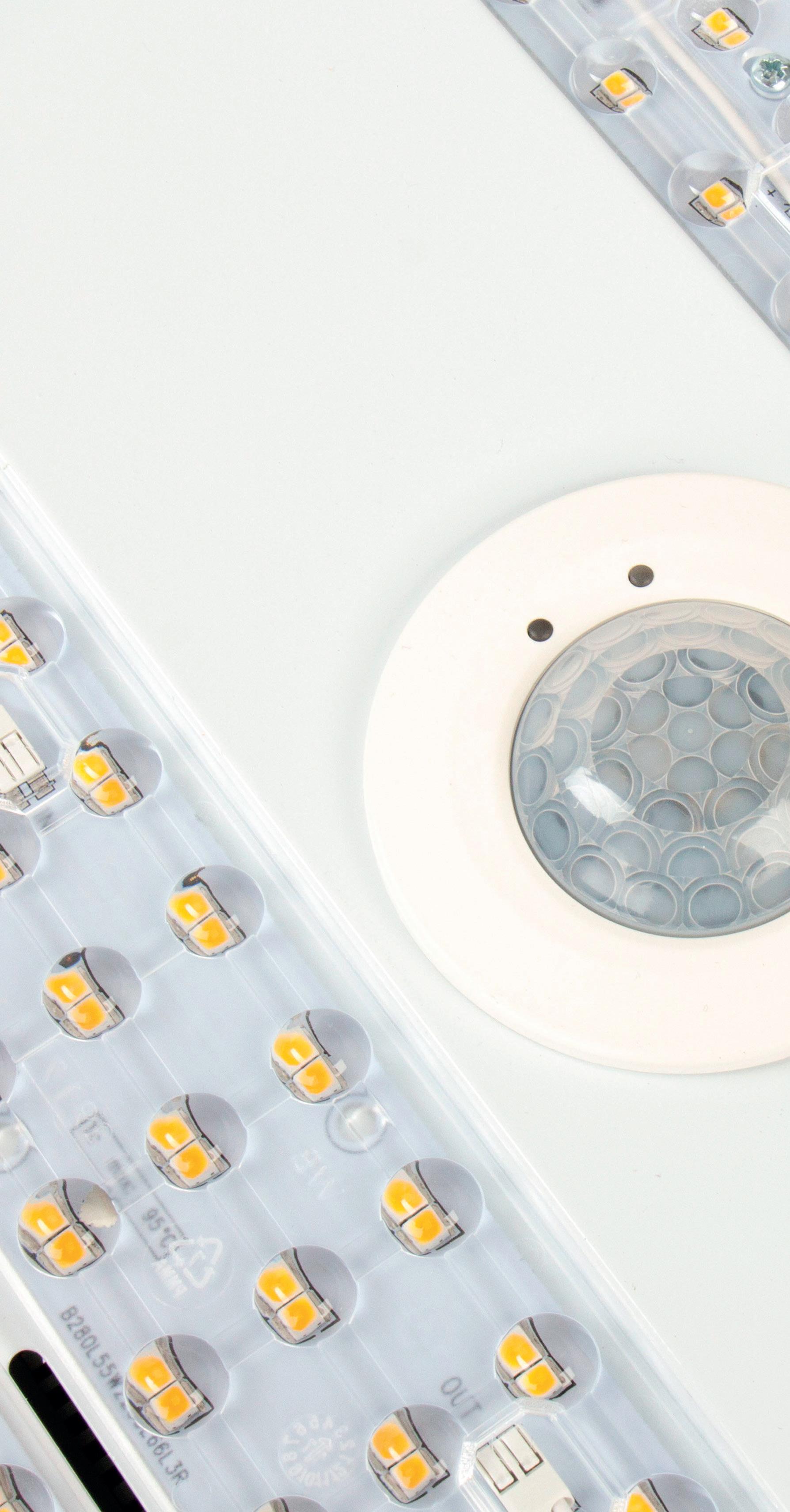























Mercury-containing and inefficient lamps are gradually being phased out. The LEDVANCE tube portfolio contains LED alternatives for every requirement and all technical circumstances. Whether it’s for ON/OFF or dimmable installations or upgrading an existing T5 and T8 metal louver luminaire with a luminaire-in-luminaire principle. ledvance.com/ledtubes

Hello and welcome to ECN’s Lighting Supplement.
In this supplement, Tamlite writes on delivering a sustainable and circular built environment. The company says that small changes can make a big difference – see page 4 for more.

Knightsbridge focuses on its new Potentia LED high bay range on page 12 –an ideal solution for industrial applications requiring versatility, flexibility, durability, control and performance.
At a time when the lighting market is changing more than ever, LEDVANCE is offering its new, significantly expanded LED lamp portfolio of future-proof lighting solutions for almost every application. Find out more on page 10.
Recolight summarises its Circular Lighting Live conference, and one of the key messages to come from the conference is that the reuse of luminaires is being normalised. Read all about it on page 12.
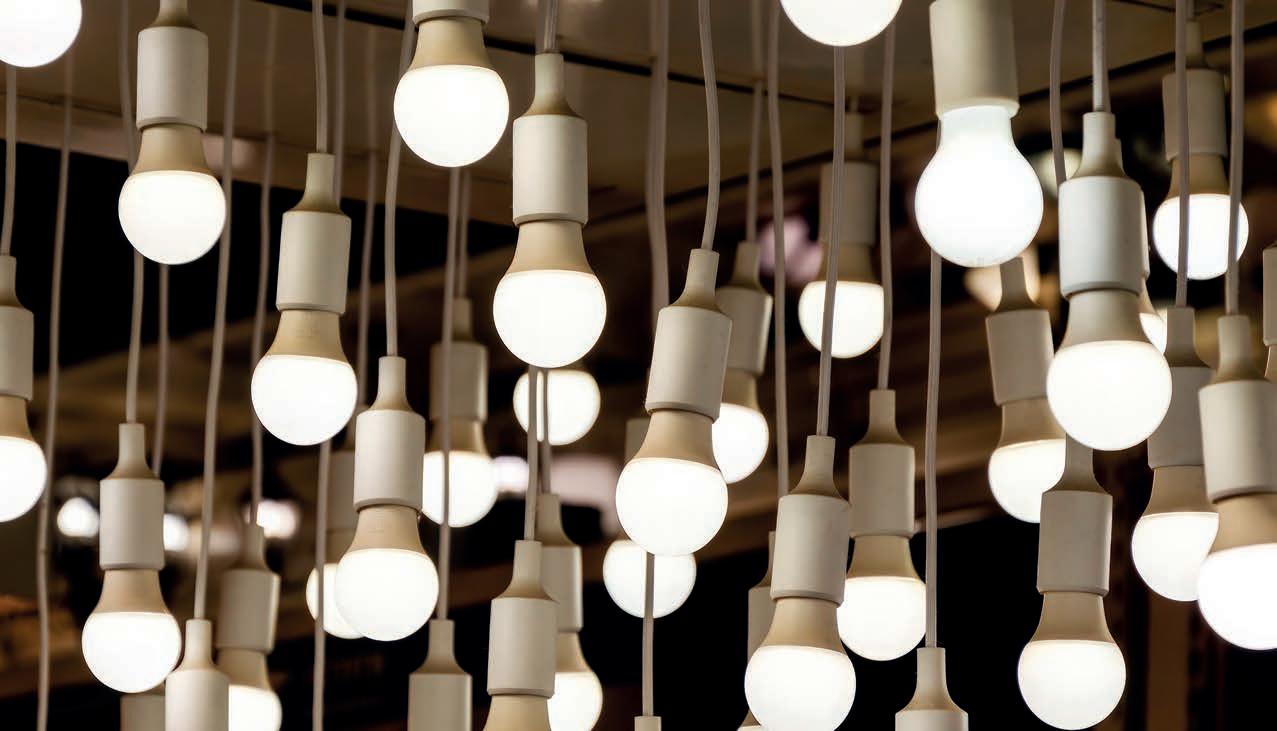
B.E.G. has launched a seventhgeneration range of encrypted occupancy sensors which incorporates ‘wellness’ HCL for the first time – learn more on page 14.
Mike Collins, Managing Director at Ovia, answers some questions on the DALI protocol on page 16, and on page 18, Phil Brown, Director of Product & Marketing at NVC Lighting, discusses why installing self-test emergency lighting systems benefits electrical contractors and their customers.
I hope you find this supplement informative – look out for our next supplement in the February issue!
As the drive towards a more circular economy and improving energy efficiency continues across the built environment, the public sector will play a key role in achieving this. Tamlite Lighting says that small changes can make a big difference.

Data released by the Department for Business, Energy and Industrial Strategy (BEIS) at the beginning of April showed that greenhouse gas emissions in Britain rose by 4.7% in 2021 compared with 2020 levels. But it’s not all doom and gloom. Compared to 2019, the most recent pre-pandemic year, total greenhouse gas emissions are down 5.2% and are 47.3% lower than they were in 1990.
With the UK government setting a legally binding goal to achieve net zero by 2050, it remains clear that urgent actions still need to be taken for emission rates to decline at a far quicker rate. Indeed, this was the warning from the Intergovernmental Panel on Climate Change (IPCC) who said that without immediate and deep emissions reductions across all sectors, limiting global warming to 1.5°C is beyond reach. Here in the UK, 2050 may seem a long way off. But with just eight years to go to reach the Government’s commitment to reduce emissions by 68% by 2030, the price of inaction is bought into sharp focus!
The built environment remains a major contributor to climate change and is directly responsible for 25% of the total UK carbon footprint, and therefore has a critical role to play in the national transition to net zero.
The public estate – Britain’s largest property portfolio – generates 2% of the UK’s total carbon emissions. That figure might not seem much, but in 2020, net territorial greenhouse gas emissions in the UK were estimated to be 405.5 million tonnes, so the public estate is generating over eight tonnes on its own! Whilst innovative low carbon technologies are often seen as the silver bullet, there are far simpler and more cost-effective measures that can be taken. And it is arguable that the public sector must prioritise retrofitting its existing assets in order to meet carbon cutting targets as well as improve their energy efficiency, especially when you consider 80% of the buildings that will exist in 2050 already exist.
Civic leaders from across Europe recognise the benefit of retrofitting solutions, with members of the C40 Cities initiative now calling on governments to scale up solutions in energy efficiency and retrofits to assist with wider decarbonisation targets.
Retrofitting and installing luminaires approved by the CIBSE and the LIA’s TM66 Circular Economy Assurance Scheme is a great start when it comes to sustainability lead projects. By partnering with CIBSE and the LIA’s Assurance Scheme, Tamlite can ensure that its luminaires are held to some of the highest standards of sustainability and environmental responsibility. Tamlite’s commitment goes beyond simply providing sustainable products; the company aims to educate and inspire the industry towards a more sustainable future.
Tamlite says it is pleased to confirm that the Tamlite EXPO is now TM66 certified. EXPO is one of the first luminaires to achieve this certification. More and more Tamlite luminaires will be achieving this certification as the company moves forward.
Lighting remains one of the most fundamental building services, yet it is here that small changes can make a big difference. The ability of LED technology to reduce energy consumption by two-thirds or more, as well as greatly increase product lifespans, is universally accepted. However, what is less understood are the actual savings that can be made and the overall ROI – in many cases, replacing outdated lighting with modern LED systems has generated savings of between 60% to 80%, and this should be seen as a key component of any decarbonisation plan.
As well as financial and environmental savings, in the vast majority of cases, high-efficiency LED lighting used in conjunction with intelligent control systems also add a level of flexibility that is vital across the public sector estate when you consider the varying use of properties.
As an example, installing PIR sensors ensures that lighting is not used unnecessarily when the room is unoccupied by dimming or switching off the fittings, while advanced controllers –such as daylight dimming sensors – allow the output of the luminaires to be adjusted in accordance with natural light levels.
Beyond that, a network which connects all fittings and sensors into a centralised control system allows building operators to establish lighting designs and settings that suit the preferences of different groups of occupants. Integrated systems like this also make it much easier to track energy usage and identify ways in which consumption can be further reduced.
The commissioning of intelligent lighting systems could be seen by many as a complex and time-consuming affair, but the latest generation of smart systems greatly reduces the impact on facilities’ cost-base, infrastructure and personnel. In this context it makes sense to engage with a specialist lighting company at the earliest possible stage, since they are able to provide expert guidance and the most effective fast-track solutions to delivering the right light when it is needed, and within budget.
In Tamlite’s Vision network, every luminaire is smart. With integrated wireless nodes, fittings can communicate with one another, be set into groups, and work as one holistic system. Using smart sensors, lighting can be switched off automatically when no one is in the vicinity. Tamlite Vision systems utilise the latest in occupancy sensing and daylight dimming technology to create better atmosphere for occupants and increase the lifespan of luminaires. Through the use of sensors, control panels and lighting networks, you can ensure that luminaires are only on when they are needed, which minimises energy usage and overall carbon output.
It is not just indoor lighting where the public sector can make a difference in improving the environment and energy efficiency. The Energy Saving Trust reports if every street lamp in the UK was upgraded to LED, it would save in the region of £77million.
Poor lighting design not only results in energy waste, but light spill and light intrusion too, with the International Dark-Sky Association (IDA) estimating that 35% of artificial light is wasted by being poorly aimed or unshielded.

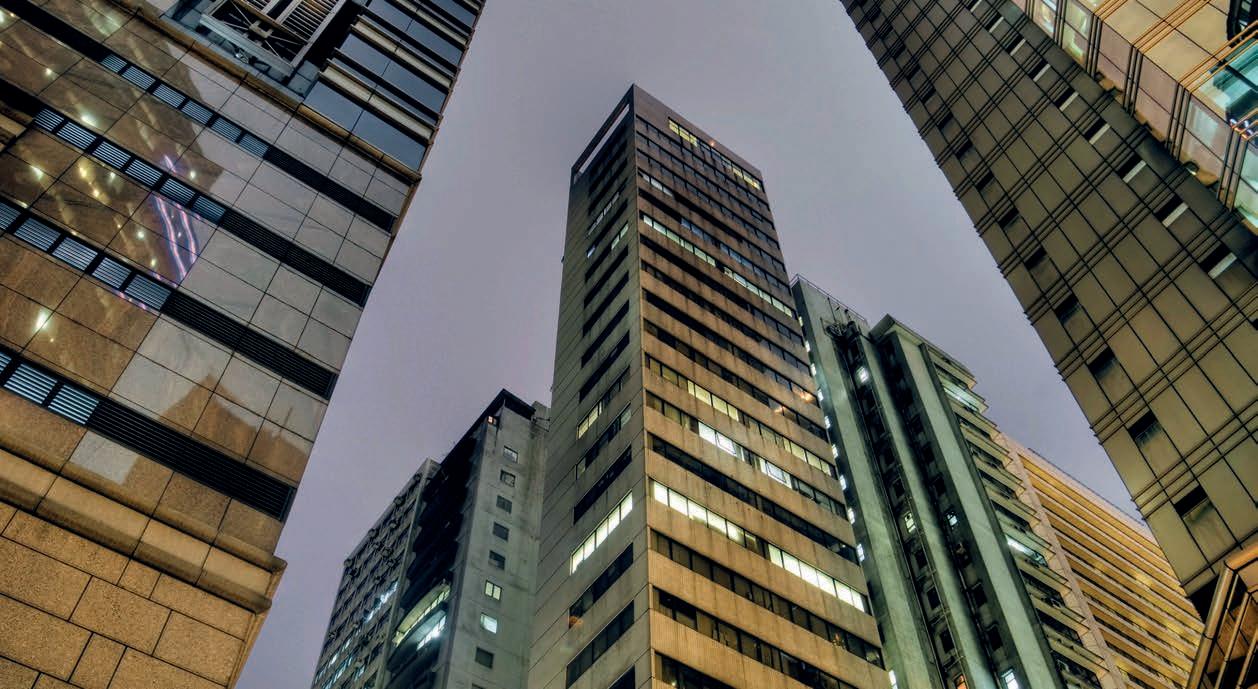
Dark Sky refers to those locations where the beauty of the night sky remains relatively untouched by the intrusion of artificial lights. These designated areas are carefully chosen to ensure that the natural darkness of the night sky is preserved, allowing us to witness the awe-inspiring wonders of the universe. To maintain this delicate balance between light and darkness, stringent measures are taken when it comes to urban lighting installations.
One way to deal with unnecessary waste is to use luminaires that are Dark Sky Certified. With Dark Sky third party certification, consumers can easily identify and support products that contribute to the preservation of our natural habitat. By choosing Dark Sky certified products, you are not only enhancing the beauty and tranquillity of the night sky, but also actively participating in the global movement towards a more sustainable future.
Tamlite urban luminaires (various from the company’s CITY RANGE for example) are at the forefront of this movement. Meticulously crafted to minimise unnecessary upward illumination and glare, these luminaires play a pivotal role in safeguarding local wildlife and reducing light pollution for the surrounding environment. With Tamlite’s commitment to creating the ideal exterior environment at night, we can revel in the beauty of the night sky while preserving the delicate balance of nature.
The nature of urban spaces may be subject to considerable variation, but it is vital for local authorities to invoke one universal design principle when delivering urban illumination: that lighting should be highly directional and provided only when and where it is needed. Combined with the warmer, more attractive nature of LED fixtures, such systems can ensure that lighting is radiated into the right space at the right time, reducing energy waste and carbon emissions.
Public sector organisations who lean towards lighting upgrades will not only reap the benefits from reducing their energy consumption but, given the hugely increased energy costs, will also see a significant reduction when it comes to ROI. With the drive
towards decarbonisation intensifying, retrofitting outdated lighting will, without doubt, be a vital step towards reducing environmental impact. Visit tword.tamlite.co.uk for more on how the lighting industry will help progress our collective sustainability efforts and achieve net zero goals.
Tamlite, tamlite.co.uk





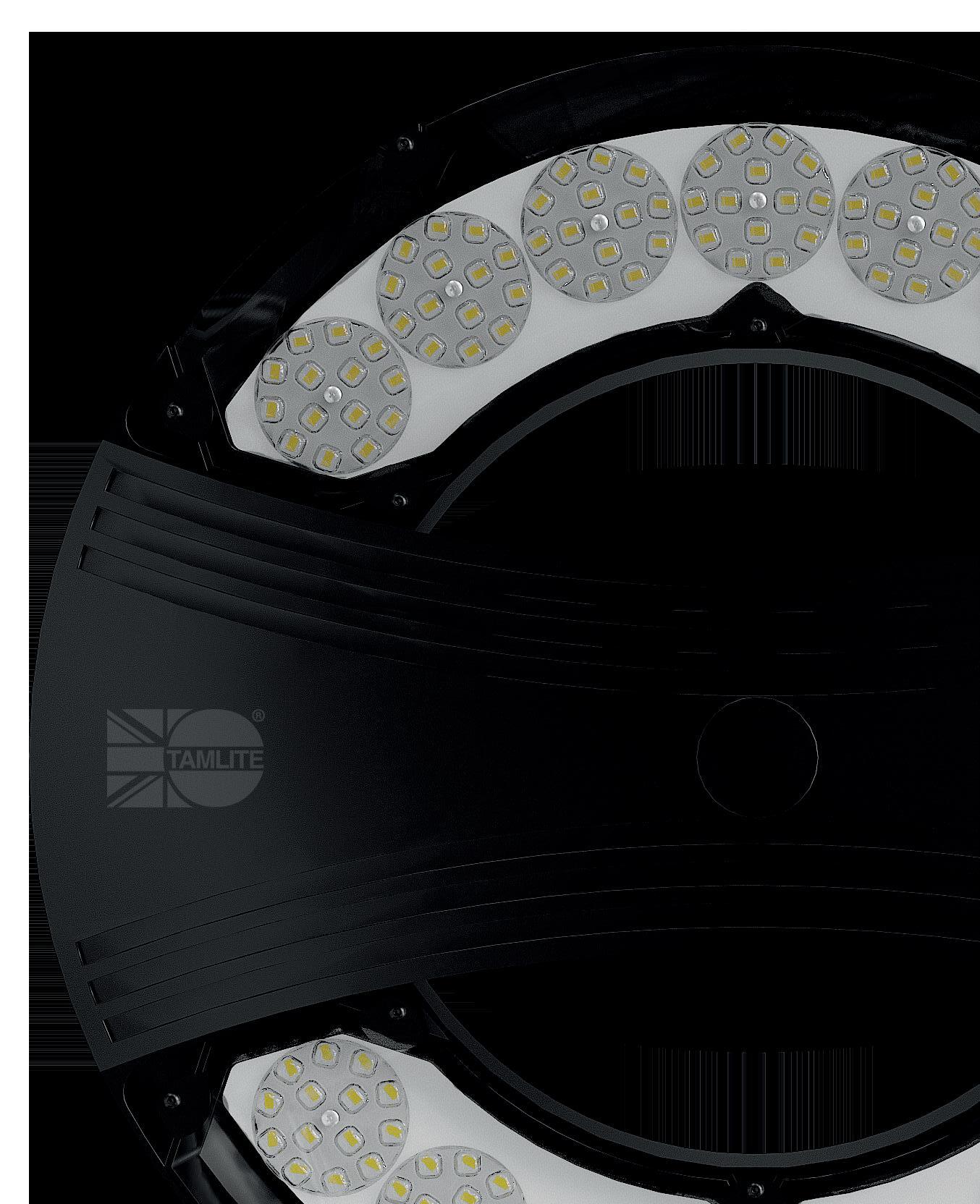

The new Potentia LED high bay range from Knightsbridge – one of the UK’s leading manufacturers of wiring accessories and lighting – provides an ideal solution for industrial applications requiring versatility, flexibility, durability, control and performance.
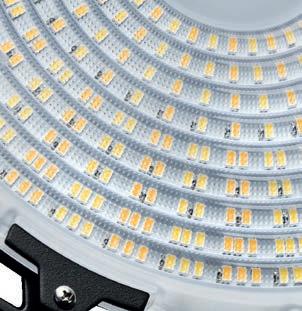
The high bays, which come in two sizes, incorporate tri-wattage and dual-CCT functions along with other innovative features to deliver long-life and powerful illumination.
The high bays feature a selectable CCT switch, allowing users to adjust the colour temperature between 4000K and 5000K according to preference; and offer wattages of either 100W, 120W and 150W or 150W, 180W and 200W, depending on model.
Suitable for the toughest industrial environments, Potentia are rated to IK08, making them resilient in the face of impacts, and also IP65, ensuring resistance against dust and water ingress. This makes them well-suited for installations in challenging indoor or outdoor settings where protection against moisture and debris is crucial.
Effective control is crucial to lighting performance, and Potentia offers a choice of approaches. First, built-in 0-10V dimming capability comes as standard, while the high bays are supplied with polycarbonate diffusers, ensuring even light distribution that makes them ideal for environments where cleanliness and hygiene are of importance.

Second, a programmable microwave sensor is available, which enables the user to set various parameters such as brightness, sensitivity, hold time, standby time and standby dimming. The sensor can be paired with a remote control, giving the ability to control settings to ensure adequate illumination while maintaining energy efficiency.
Finally, when used with an addressable Digital Addressable Lighting Interface (DALI) control system, the DALI module allows the installer to assign an address and a control group to the fixture; this address and control group allows for grouping of fixtures into zones.
Other accessories available include a 60° lens modifier, which reduces the beam angle from 90° to 60° – important for high-ceiling installations, a smaller beam angle is required – and surface mounting brackets which allow for flush mounting and so increase the number of applications for which Potentia is suited.
With a five-year warranty and cutting-edge LED technology, Potentia is
built to last, boasting an L90B10 rating of 50,000 hours, guaranteeing longevity and consistent performance.

With Potentia, Knightsbridge delivers a powerful LED lighting solution for industrial applications that combines innovation, durability, and safety.
Knightsbridge, mlaccessories.co.uk
















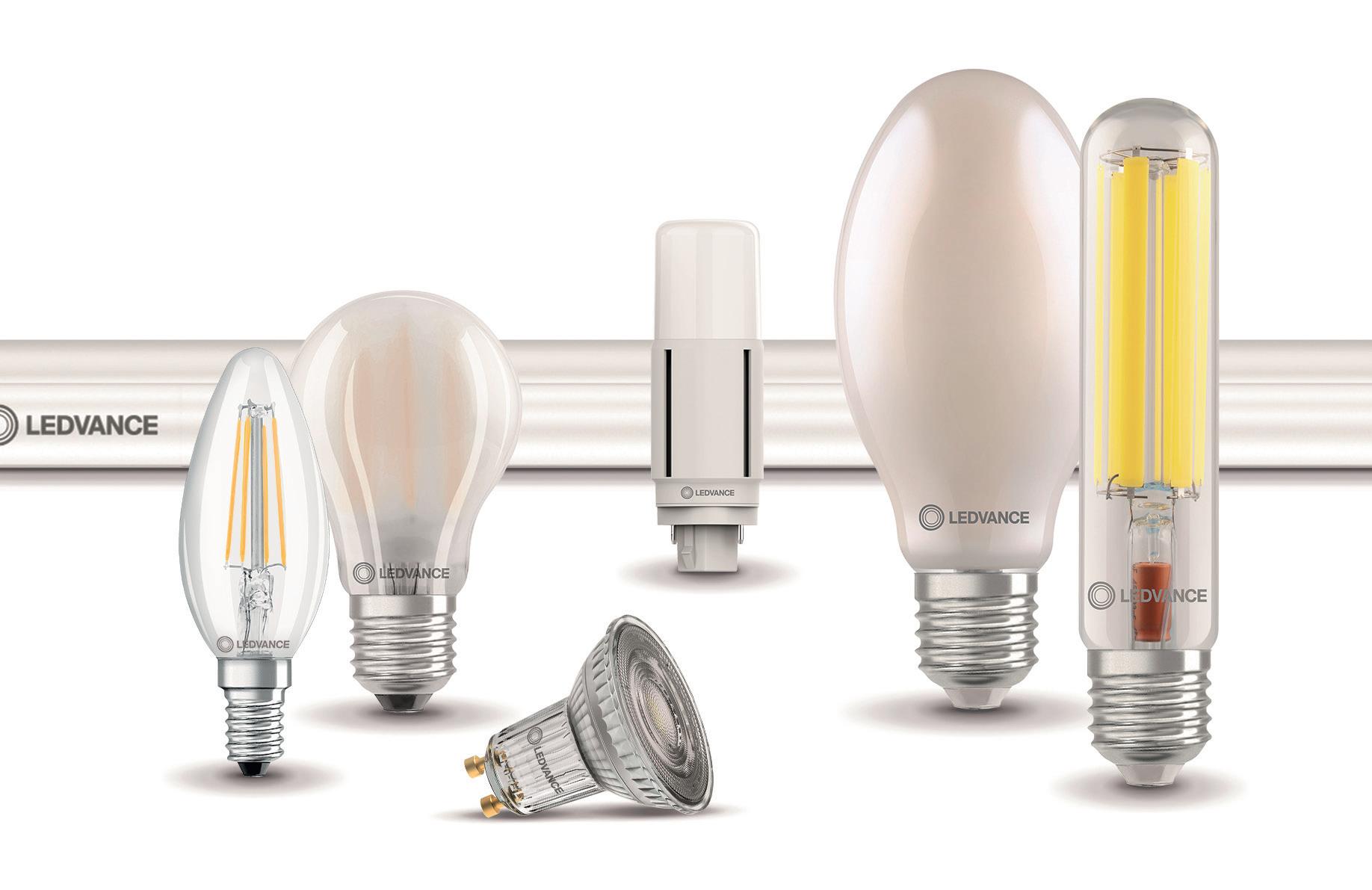
At a time when the lighting market is changing more than ever, LEDVANCE is offering its new, significantly expanded LED lamp portfolio of future-proof lighting solutions for almost every application. You can quickly and easily find the right lamp thanks to clear structuring and the fact that professional LED lamps now bear the name LEDVANCE.
In the fight against global warming and pollution, Europe is imposing a ban during 2023-24 on the sale of inefficient lamps containing mercury. This will mainly affect traditional fluorescent lamps. The LEDVANCE portfolio, therefore, offers future-proof LED alternatives that cover virtually any application in industrial, office, warehouse or street lighting – both today and tomorrow.
To make the transition to LED technology as simple as possible, LEDVANCE is offering its professional range of lamps under its own name.
What’s more, many of the products are now even more powerful, to coincide with the change of brand. Lighting professionals just need to remember one thing – if it says LEDVANCE, you know the product is high-quality, efficient and future-proof.
LEDVANCE’s extended LED lamp portfolio includes the LED TUBE and DULUX LED families, which now have more future-oriented LED alternatives than ever before. Lamps with classic shapes and lamps for street lighting have also become even more diverse, more efficient and more cost-effective.

The RoHS lamp ban affects traditional fluorescent lamps in particular. The LED TUBE range has the right LED alternative, whatever the requirement – for ECGs, CCGs or mains voltage, T8 or T5. In addition to the familiar standard lengths and colours, there are new Ultra Output versions, lamps with greater efficiency and longer life, energy efficiency class B, new light colours and excellent CRI 90 colour rendering.


As direct replacements for CFLni lamps affected by the lamp ban, DULUX LEDs without integrated control gear deliver high-quality light, good light distribution, high cost-effectiveness and short payback times and can operate on 230V AC. Compared to traditional CFLni lamps, they save up to 60% energy and last two to three times longer. Newcomers to the range include direct replacements for DULUX LED SQUARE EM GR8, DULUX LED D VERTICAL G24d and DULUX LED T Gx24d.
With their full glass bulbs, which outwardly are hardly distinguishable from those of traditional HQL and NAV lamps, along with their high efficiency, the new LEDVANCE HQL and NAV LED FILAMENT lamps are ideal one-for-one replacements for mercury and sodium vapor lamps. They are suitable for operation on CCG or 230V mains voltage, extremely lightweight and available in light colours, 2,700K and 4,000K. Thanks to 360° light distribution, existing reflectors can continue to be used without any problems. What’s more, you get 100% light without any warm-up time.

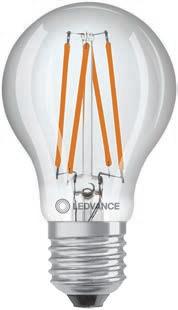


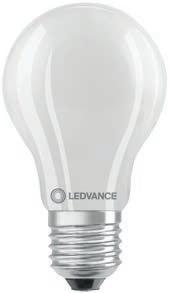

LEDVANCE LED lamps in classic bulb and base shapes also have more to offer than ever before. LED FILAMENT CLASSIC A DIM with energy class B and up to 60% energy savings represent improvements over conventional LED CLASSIC A lamps. LED FILAMENT CRI 97 DIM lamps in the impressive premium portfolio produce pleasant natural light with optimum colour rendering. And LED MOTION SENSOR CLASSIC comes with an integrated daylight and motion sensor for even greater efficiency.
LEDVANCE, ledvance.com
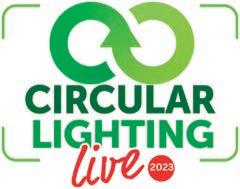
The event, held in the main auditorium of the Royal College of Physicians in London, brought together 290 registered delegates for the most comprehensive review of circular economy progress in the lighting industry. A total of 35 speakers and panellists provided a fully thorough review of the legislation, and actions that companies in the UK and elsewhere are taking to drive forward the circular economy.
Commenting on the event, chair Ray Molony said, “This imaginative new thinking is leading to new business models and the growth of a vibrant remanufacturing sector in the lighting industry. Remanufacturers take used lights, upgrade them to the latest efficient LEDs and wireless controls and then –crucially – warranty them.”
Major commercial real estate developers, their architects and design teams are beginning to either reuse existing luminaires by retrofitting upgrades, or in a few cases, use luminaires from a completely different building.
Delegates heard presentations from clients who had reused luminaires, included Rolls Royce, Cambridge University, The Holburne Museum, Dublin Port Tunnel and Building Craft College.
The Recolight Reuse Hub was launched at the conference. It provides an online digital marketplace for the donation and reuse of lighting products. That can either be brand new stock that will not be sold, or used product that could be remanufactured.
Currently, very few used luminaires are re-used. Some are in very good condition before removal and therefore a lot of the value and embedded carbon is lost if they are recycled. Recolight wants to make it as easy as possible for companies to hand over surplus and used products to third-parties, who can put the them to good use.
The regulatory landscape is set to change dramatically, with many circular economy regulations and directives being developed at EU level. These include the Ecodesign for Sustainable Products Regulation (ESPR), Right to Repair legislation and a raft of other rules affecting green packaging, sustainability information, substantiating green claims, chemicals and waste. Maurice Maes, Head of Standards and Regulation at Signify, gave an essential update on the regulations and how they will affect businesses in the lighting supply chain.
Maurice said, “It has been a fantastic experience to witness the green ambitions of the UK lighting industry and to see the many innovative circular designs and successful remanufacturing projects. I am sure the Recolight Circular Lighting Live event will further fuel and accelerate this amazing trend.”
Specifiers and end users are now asking for a wide range of environmental metrics, including environmental product declarations (EPDs) life cycle assessment (LCAs), and embedded carbon calculations (such as TM65) and circularity assessments (e.g. TM66).
Leela Shanker – Founder of the Life Cycle Assessment Incubator of
the GreenLight Alliance and IALD said, “We need a global approach to align emerging carbon accounting and material transparency frameworks. This will allow us to keep moving with the best ideas from around the world, save designers time in upskilling, give manufacturers certainty on the business case for reporting and, ultimately, accelerate implementation of circular design principles and decarbonisation strategies.”
The GreenLight Alliance plans to publish EPDs from five types of generic fixtures and this can be used as a benchmark for specifiers. GreenLight has also issued a document with generic but meaningful language to help designers protect their specifications.
Delegates heard of the changes to CIBSE specifications TM65 and TM66. Both specifications were widely lauded as providing effective ways in which lighting producers can assess and publicise the sustainability of their products, and specifiers can compare the sustainability credentials of similar products.
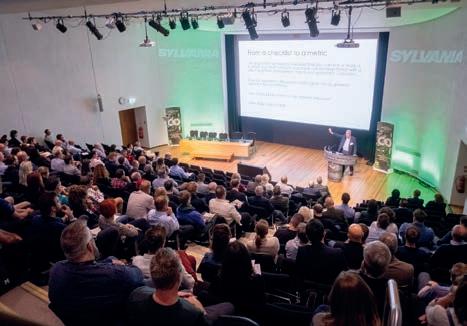
The conference also highlighted considerable concerns regarding the level of waste associated with Cat A fitouts. All too often, brand new luminaires are removed and scrapped when a fully fitted out building is handed to new tenants. A number of solutions to tackling this waste were considered.
Summarising the event, Nigel Harvey, CEO of Recolight, said, “It was truly inspirational to see so many examples of organisations that are putting the circular economy into practice. The vital significance of the conference was thrown into sharp focus by the deeply disappointing announcement that the government is watering down key climate action policies. It is clear given this lack of ambition, it is the corporate sector that must now rise to the challenge.”
Recolight, recolight.co.uk
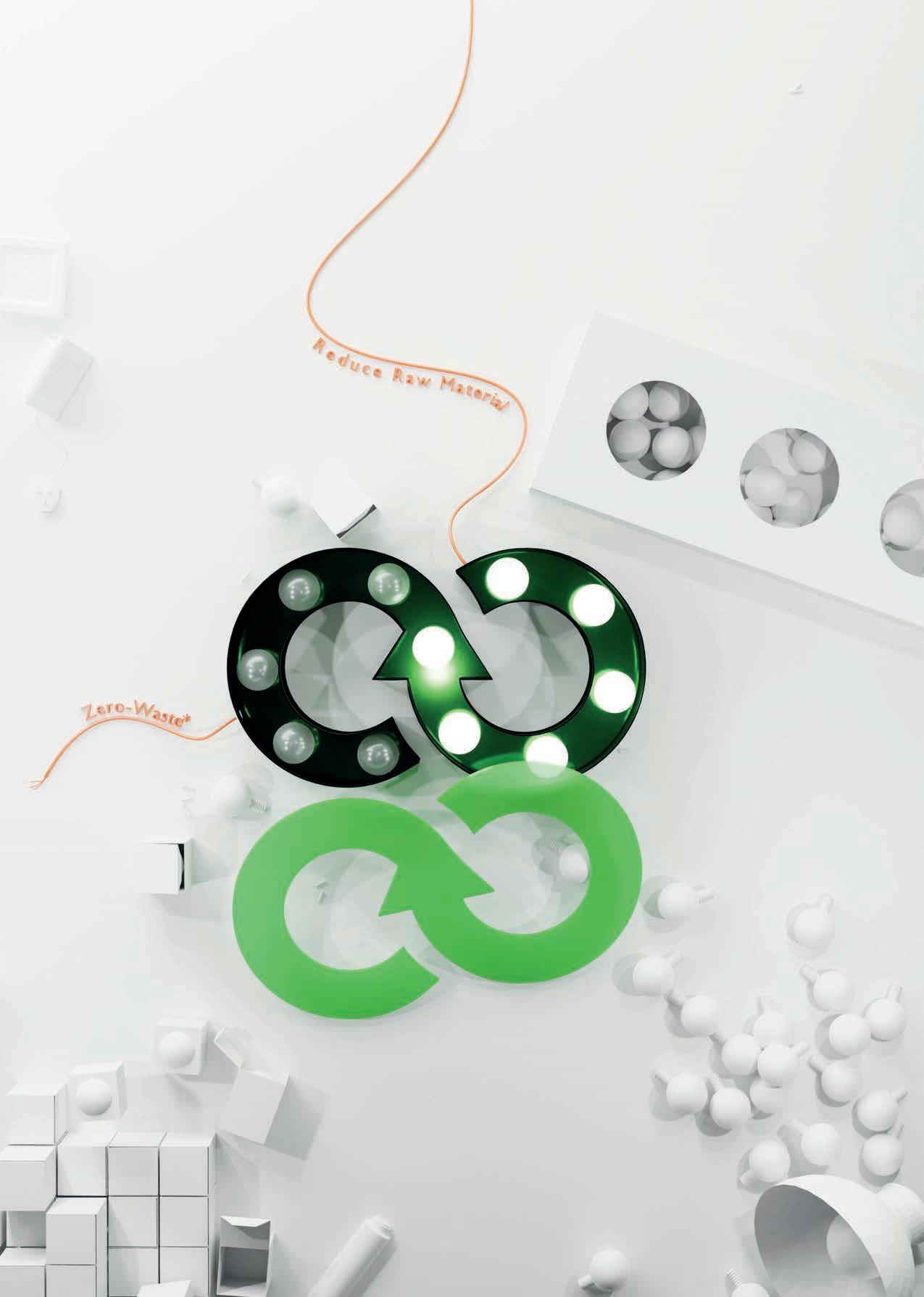








B.E.G. has launched a seventh-generation range of encrypted KNX occupancy sensors which incorporates innovative ‘wellness’ Human Centric Lighting technology for the first time.
The German manufacturer has updated the multi-sensor series to include HCL and create lighting by mimicking the natural daylight outside based on time, presence, and circadian rhythm of the occupants in the room. The technology ensures a sense of wellbeing in the room via colour-matched ambient lighting that can be operated by end users via a smartphone using the B.E.G. One app.


Paul Jones, Sales Director of UK and Ireland at B.E.G., says, “The dimming of the individual lights is continuous and harmonious so that the change is not directly visible, but the quality of the artificial light is significantly improved. HCL technology has been proven to enhance human performance, comfort, and health of staff and employees.”
B.E.G. has also incorporated HCL into the new KNX Generation Seven range as it reduces energy consumption, making it a greener and more environmentally friendly lighting control solution for end users. The manufacturer also says the new series makes building automation ‘easier than ever’ for electrical contractors to install and end users to operate.

Generation Seven includes optimum room climate thanks to an integrated temperature sensor, which means the temperature in each individual room can be controlled, while an offset control enables different brightness levels to be selected.
B.E.G. has introduced a DALI/KNX gateway to the range, in line with the new KNX generation, so that motion and occupancy sensors, as well as push buttons, can be incorporated into the DALI
bus, in addition to luminaires. This will make installations ‘quicker and simpler’ for electrical contractors and more cost effective for end users.
All KNX Generation Seven sensors feature KNX Secure which extends the IP protocol, so all transferred telegrams and data are totally encrypted. KNX Data Secure has been designed to protect user data against unauthorised access and manipulation by means of encryption and authentication.
B.E.G. also offers hardware which is optionally available with an integrated microphone, a temperature sensor and internal LED for orientation and night light functions. In addition to the PIR sensors, acoustic signals can also be used for movement detection.
B.E.G., beg-luxomat.com
■ Addressable multi-master Lighting Control System

■ Supports DALI and DALI-2 luminaires
■ Ideal for retrofitting
■ Super flat multisensor available
■ Simple, intuitive operation
■ Free Bluetooth app with 2 functions:
- Scene control for end customer
- Commissioning tool for installers

♦ A new range of passive infra-red occupancy detectors, switches and dimmers




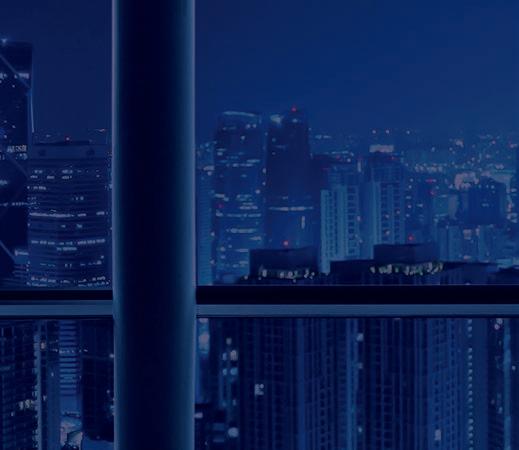

♦ Quad digital person detector with adjustable photocell and time lag functions
♦ Mini detector head is ideal for false or plasterboard ceilings, or for fitting into a luminaire

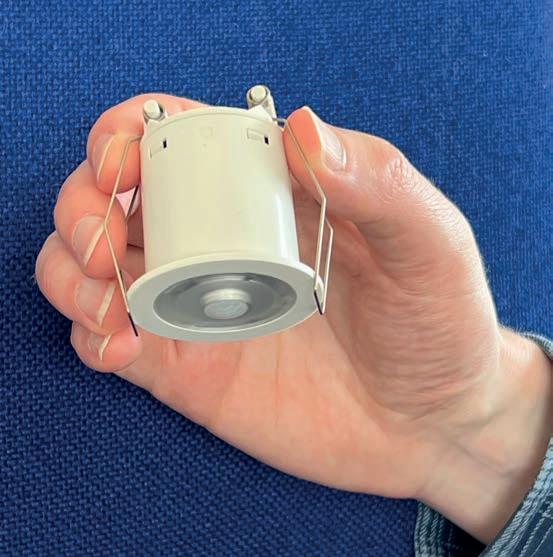
♦ Ideal for energy-saving automatic lighting control


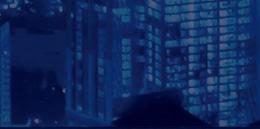


♦ Versions for up to 7m diameter detection at 5m mounting height or up to 24m diameter detection at 17m mounting height



♦ Versions for Mains Switching, DALI or 0-10V dimming


♦ Easy programming with the DANLERS ISI app





with separate power pack with connector Smart ISI range
For further details, visit our website or give us a call
Originating in the late 1990s, DALI (Digital Addressable Lighting Interface) is a bi-directional communications protocol that is used to provide control over, and communication between, the components in a lighting system.
• It is an open protocol – any manufacturer can use it.
• With DALI-2, interoperability between manufacturers is guaranteed by mandatory certification procedures.
• Installation is simple. Power and control lines can be laid together and no shielding is required.
• The wiring topology can be in the form of a star (hub and spoke), a tree or a line, or any combination of these.
• Communication is digital, not analogue, so the exact same dimming values can be received by multiple devices, resulting in very stable and precise dimming performance.
projected to continue to grow for the foreseeable future,

– answers some questions on
for lighting.
• All devices have their own unique address in the system, opening a very wide range of possibilities for flexible control. This also allows all devices to be individually monitored and maintained.
DALI, like 1-10V, was designed for and by the lighting industry. Lighting control components, such as LED drivers and sensors, are available from a range of manufacturers that have DALI and 1-10V interfaces. However, that’s where the similarity ends. The main differences between DALI and 1-10V are:
• DALI is addressable. This opens the way for many valuable features such as grouping, scene-setting and dynamic control, such as changing which sensors and switches control which light fittings in response to office layout changes.

• DALI is digital, not analogue. This means that DALI can offer much more precise light level control and more consistent dimming.
• DALI is a standard, so, for example, the dimming curve is standardised, meaning that equipment is interoperable between manufacturers. The 1-10V dimming curve has never been standardised, so using different brands of drivers on the same dimming channel could produce some very inconsistent results.
• 1-10V can only control switching on/off and simple dimming. DALI can manage colour control, colour changing, emergency lighting testing and feedback, complex scene-setting and many other lighting-specific functions.
The core of DALI is a bus – a pair of wires that carry digital control signals from input devices (such as sensors) to an application controller. The application controller applies the rules with which it has been programmed to generate outgoing signals to devices such as LED drivers.
• Bus power supply unit (PSU). This component is always required. It maintains the bus voltage at the required level.
• LED fittings. All light fittings in a DALI installation require a DALI driver. A DALI driver can accept DALI commands directly from the DALI bus and respond accordingly. The drivers can be DALI or DALI-2 devices, but if they are not DALI-2 they will not have any of the new features introduced with this latest version, such as querying control gear failure, resending failed commands, or identifying devices.
• Input devices – sensors, switches etc . These communicate with the application controller using 24-bit data frames. They do not communicate directly with the control devices (DALI 2 only).
• Instances. Often, a device such as a sensor will contain a number of separate devices within it. For example, sensors often include a movement detector (PIR), a light-level detector and an infra-red receiver. These are called instances – the single device has three instances. With DALI-2, each instance can belong to a different control group and each can be addressed to control different lighting groups.
• Control devices – application controller. The application controller is the ‘brains’ of the system. It receives 24-bit messages from the sensors (etc.) and issues 16-bit commands to the control gear. The application controller also manages the data traffic on the DALI bus, checking for collisions and re-issuing commands as necessary.
As a business, Ovia is continually developing products that incorporate the latest technology and its list of fittings that are compatible with the DALI protocol continues to be expanded. The company recently introduced a DALI signal converter which will transform 0-10V/PWM dimmable light fittings, such as Ovia’s Hion and Grus highbays, to DALI dimmable light fittings.
Easy removal for maintenance, circuit testing & replacing components


Fast-Fit Connectors with Push-in Lever Terminals
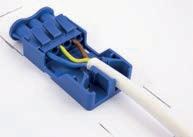

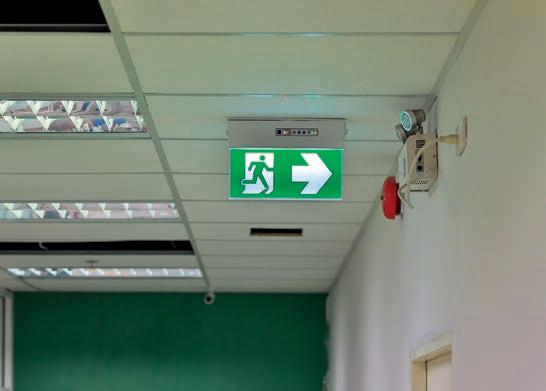
In the world of electrical contracting, safety is paramount. Ensuring that buildings are equipped to handle emergencies is not just a best practice; it’s a legal requirement. One crucial element of this safety infrastructure is emergency lighting. Phil Brown, Director of Product & Marketing at NVC Lighting, discusses why installing self-test emergency lighting systems benefits electrical contractors and their customers.

Emergency lighting is not a luxury; it’s a necessity. It’s the quiet sentinel in our buildings, always ready to guide us to safety when disaster strikes. While we hope we never have to rely on it, the presence of reliable emergency lighting is a source of reassurance. It’s the difference between chaos and order in the event of an evacuation. To ensure its reliability, emergency lighting must be routinely tested. Monthly checks, complemented by an annual full discharge test, are standard practices, as mandated by the British Standard BS 5266.
There are three primary tiers of emergency testing systems: manual, self-test and addressable self-test. Each comes with its own set of advantages and drawbacks. The crème de la crème of these systems is the addressable self-test solution, offering a raft of advantages, including automation, scheduling, and proactive fault reporting.
Manual testing: The most basic of the three, manual testing relies on human intervention. While it gets the job done, it’s prone to human error and may not be the most efficient option for larger buildings.
Self-test systems: These systems take a step towards automation by conducting tests at predetermined intervals. However, they still require manual inspection to verify results, and the testing schedule may not always be convenient for building occupants.
Addressable self-test: This is the gold standard. Addressable self-test systems offer full automation, ensuring that tests are never skipped or overlooked, and at zero additional cost. These systems can be programmed to conduct tests at times that are least disruptive to building occupants, such as avoiding school hours in educational institutions and performance times in cinemas. Test results are automatically sent to the responsible party, eliminating the need for manual record-keeping.
Historically, addressable self-test systems required a DALI (Digital Addressable Lighting Interface) network. While suitable for larger buildings, this technology was often deemed too costly and complex for smaller applications. This posed a challenge for electrical contractors looking to promote these systems. However, times have changed, and addressable self-test systems have undergone a transformation.
Modern addressable self-test systems use Bluetooth mesh technology, eliminating the need for a wired DALI network. Control is at your fingertips through a user-friendly smartphone or tablet app. Astonishingly, a single system can support up to 42,000 emergency fittings, making it versatile enough for a wide range of applications. Testing becomes fully automated,
following a pre-established schedule, with comprehensive results available on demand via the app – a significant departure from the manual systems that required painstaking record-keeping.
The advent of Bluetooth-based addressable self-test systems has transformed the landscape for electrical contractors and building owners alike. These systems offer a win-win scenario. For electrical contractors, this innovative solution is a breeze to install. Addressable self-test systems have always represented the Premier League of emergency lighting, and now, thanks to Bluetooth mesh technology, they are not only cost-effective but also straightforward to install.
NVC Lighting has a comprehensive range of lighting products for commercial, industrial and public buildings which integrate with Bluetooth-based addressable self-test systems.
The installation of self-test emergency lighting systems, especially addressable self-test systems powered by Bluetooth mesh technology, represents a leap in building safety. This innovation not only elevates the reliability and efficiency of emergency lighting testing but also simplifies the maintenance process. As technology continues to advance, the integration of these systems is becoming increasingly accessible and cost-effective, offering a bright and safer choice for buildings, their occupants, and the dedicated electrical contractors who make it all possible.
NVC Lighting, nvcuk.com



More than 100 years of tradition.
7 years of LEDVANCE.
Having emerged from the general lighting division of OSRAM, LEDVANCE has established itself as a leading name in innovative LED solutions in just seven years. We are now taking the next logical step in Europe by offering our professional range of lamps under our own name. Thanks to our know-how based on more than 100 years of experience, our new LEDVANCE LED lamps are more impressive than ever. But the best thing is you now get our full professional portfolio from a single brand – from LED lamps, strips, drivers and luminaires to light management systems and human centric lighting. This makes our support for you simpler, more extensive and more focused than ever. LED IS LEDVANCE. You can count on us.
We are committed to sustainability. Find out more at ledvance.com/sustainability
